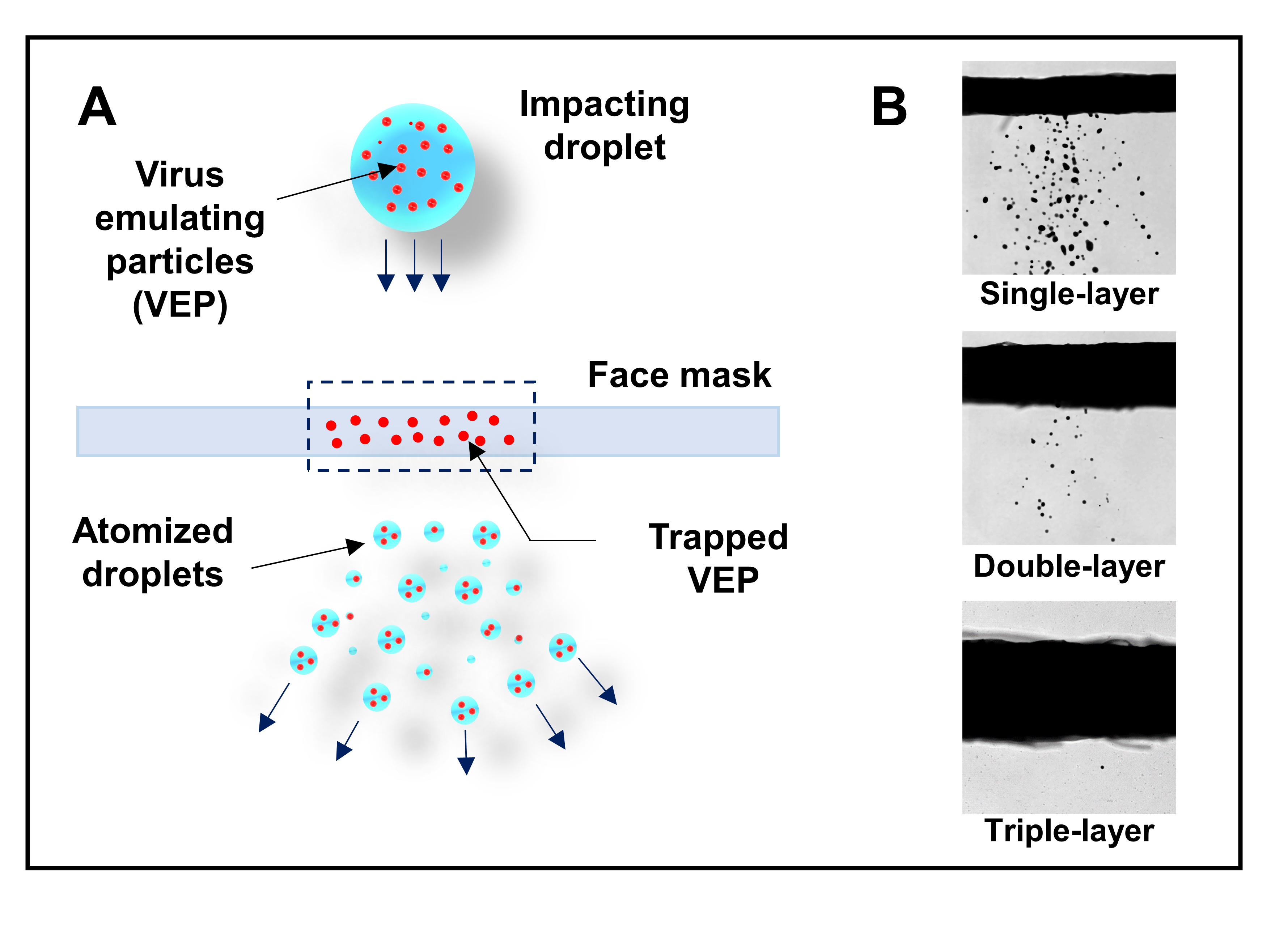– Ranjini Raghunath
When a person coughs, large droplets (>200 microns) hit the inner surface of a mask at a high speed, penetrate the mask fabric and break up or “atomise” into smaller droplets, which have a greater chance of aerosolisation and thereby carrying viruses like SARS-CoV-2 with them, according to a new study led by researchers at the Indian Institute of Science (IISc).
Using a high-speed camera, the team closely tracked individual cough-like droplets impinging on single-, double- and multi-layered masks, and noted the size distribution of the “daughter” droplets generated after penetration through the mask fabric. For single- and double-layered masks, most of these atomised daughter droplets were found to be smaller than 100 microns, with the potential to become aerosols, which can remain suspended in the air for a long time and potentially cause infection.
“You are protected, but others around you may not be,” says Saptarshi Basu, Professor in the Department of Mechanical Engineering and senior author of the study published in Science Advances.
Triple-layered masks ‒ even those made of cloth ‒ and N95 masks were found to successfully prevent atomisation, and therefore offered the best protection. The researchers, however, clarify that when such masks are unavailable, even single-layered masks may offer some protection, and hence must be used wherever mandated by health officials.
Face masks can significantly reduce virus transmission by blocking both large droplets and aerosols, but their efficiency varies with the type of material, pore size and number of layers. Previous studies have looked at how these droplets “leak” from the sides of masks, but not at how the mask itself can aid in secondary atomisation into smaller droplets. “Most studies also don’t look at what is going on at the individual droplet level and how aerosols can be generated,” Basu adds.
To mimic a human cough, the team used a custom droplet dispenser to pressurise a surrogate cough liquid (water, salt with mucin, and a phospholipid) and eject single droplets onto the mask. “The pressurisation increases the velocity of the droplet and the [nozzle] opening time determines the size,” explains Shubham Sharma, a PhD student in the Department of Mechanical Engineering and first author of the study. “Using this, we could generate droplets ranging from 200 microns to 1.2 mm in size.”

A) Schematic showing atomisation of impacting droplet into numerous daughter droplets after penetration through the face mask
B) Experimental images showing the extent of penetration through single-, double- and triple-layer face masks (from top to bottom in sequence)
Credits: Shubham Sharma and Roven Pinto, adapted from the Science Advances publication
The team used a pulsed laser to cast shadows of the droplets, and a camera and zoom lens to capture images at high speeds (20,000 frames per second). Apart from surgical masks, some locally sourced cloth masks were also tested. The team also investigated the effects of varying the speed at which the droplet is ejected and the impingement angle.
They found that single-layered masks could only block 30% of the initial droplet volume from escaping. Double-layered masks were better (about 91% was blocked), but more than a quarter of the daughter droplets that were generated were in the size range of aerosols. Droplet transmission and generation was either negligible or zero for triple-layered and N95 masks.
The team also dispersed fluorescent nanoparticles of the same size as the virus in the artificial cough droplets to show how these particles can get entrapped in the mask fibres, underscoring the importance of disposing the masks after use.
The study was carried out in collaboration with scientists Abhishek Saha in UC San Diego and Swetaprovo Chaudhuri in University of Toronto Engineering. The researchers hope to pursue further studies using a full-scale patient simulator that would also allow tracking multiple droplets. “Studies are also going on to propose more robust models to understand how this atomisation is actually taking place,” says Basu. “This is a problem not just for COVID-19, but for similar respiratory diseases in the future as well.”
S. Sharma, R. Pinto, A. Saha, S. Chaudhuri, S. Basu, On secondary atomization and blockage of surrogate cough droplets in single- and multilayer face masks. Sci. Adv. 7, eabf0452 (2021).
https://advances.sciencemag.org/content/7/10/eabf0452.full
CONTACT:
Saptarshi Basu
Professor
Department of Mechanical Engineering
Indian Institute of Science (IISc)
sbasu@iisc.ac.in
+91-80-22933367
Shubham Sharma
PhD student
Department of Mechanical Engineering
Indian Institute of Science (IISc)
shubhams12@iisc.ac.in
NOTE TO JOURNALISTS:
a) If any of the text in this release is reproduced verbatim, please credit the IISc press release.
b) For any queries about IISc press releases, please write to news@iisc.ac.in or>pro@iisc.ac.in



